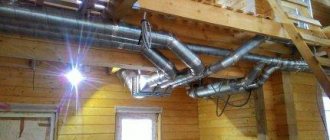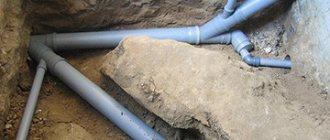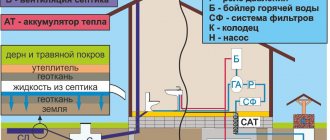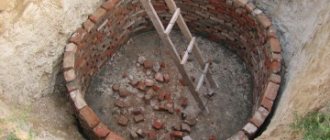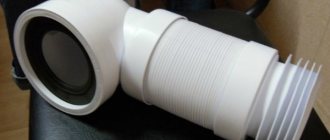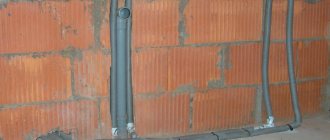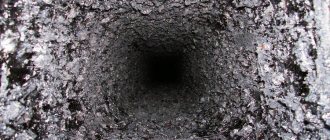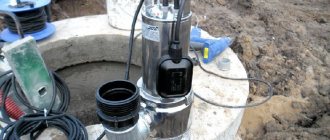Owners of apartments on the top floors of apartment buildings, as well as owners of private low-rise housing, often express their displeasure about the thick pipe in the toilet that spoils the interior, going into the ceiling and then onto the roof. The liquid does not drain through it - the drainage is carried out below, so some people want to get rid of this bulky structure for the sake of aesthetics. Is this possible, and in what cases? Why is this pipe needed at all? Let's try to figure it out by referring to the requirements of domestic construction standards, including SP 30.13330.2012 “Internal water supply and sewerage of buildings,” as well as taking into account practical realities.
Features of the ventilation system for sewerage
Ventilation in the sewer system in a private house must be equipped if the communication structures are combined into risers with a cross-section of 50 mm.
And also provided that if the building has 2 or more levels, the building is equipped with water supply and sewerage.
Ventilation in a private house
Ventilation for sewerage in a private house is as follows: each plumbing equipment has a siphon in the form of a curved pipe (there is always water in it).
Thus, a water seal is created on the side of the septic tank - the treatment device, and, accordingly, the spread of unpleasant odors along the riser is prevented. Is sewer ventilation necessary in a private house?
If you are not a supporter of “extreme” living conditions, then you definitely need it.
Operating principle of ventilation
There are certain rules according to which ventilation of the sewer riser is installed.
The most important of them read:
- the minimum height at which the vent pipe is installed above the roof is 1 m;
Position of the drain pipe on the roof
- in order to combine several systems into one, pipes with a diameter of 50 or 110 mm are required;
Optimal pipe diameter 110 mm
- It is strictly forbidden to combine the sewer ventilation outlet with a chimney or general ventilation system of the room;
- It is not allowed to install a cap on the outlet section of the drain pipe, because in this case condensation may form, and in winter this threatens with ice plugs;
Installation of a fvn pipe cap is not allowed
- The sewer hood in a private house should not be under the weight of the roof, this will avoid pipe breakage under the influence of snow and ice.
Remember one thing: knowing how to install sewer ventilation in a private house, you can ensure comfortable living and prevent your home from filling with foreign odors and gases.
Ventilation diagram in your home
Fan riser: purpose and consequences of its absence
In short, the sewer drain riser is nothing more than ventilation. Its main task is to ensure air flow inside the sewer system, which ensures its ability to quickly cope with the transportation of large volumes of water and remove unpleasant odors. Let's be honest - the relevant housing office services have a negative attitude towards the issue of removing this part of the riser, even if it is being replaced with an air valve. Why? Everything is simple here - its absence entails a lot of problems that begin to fall one after another on their heads. And although these troubles can be counted on one hand, they can make life unbearable for residents of a high-rise building. Such problems include the following.
- A foul smell spreading through the apartments located along the riser where the vent riser was cut out and plugged. This behavior of the sewer system is due to the fact that the smell has nowhere else to go and instead of freely ventilating through the ventilation pipe, it seeps through even the smallest pores in the apartment’s pipe connections. The situation is further aggravated by the fact that when flushing the toilet, a large amount of water immediately enters the sewer system, acting like a piston, drawing in air, which, in the absence of a drain pipe, has nowhere to come from. The system itself looks for where to get it and finds it in the most unexpected places for a person - it simply sucks out the water seals in the siphons of the bathtub, washbasin or kitchen sink and begins to suck in the necessary air in these places. The result, again, is unpleasant odors spreading throughout the apartment. This does not happen in just one apartment - as mentioned above, all the lower floors located along the riser will suffer.
- Problems with the operation of the sewer system. In addition to draining the water seals, the absence of a drain pipe certainly affects the operation of the sewer system - as a rule, it begins to clog more often. The lack of the same full air flow does not allow the system to quickly and effectively remove human waste. This nuance is especially true for sun loungers - if before you had no trouble with them, now you will have to clean them with enviable regularity.
Now decide for yourself whether you need a fan riser in your apartment or maybe it’s better to put up with its presence? By the way, if you are a resident of a private house, then you should not think that you will not have such problems. It should be understood that no matter the size of the sewerage system and no matter how correctly it is assembled, the drain riser is its integral part, and its full replacement simply does not exist. Think about this at your leisure, but for now I’ll tell you about one alternative that supposedly allows you to remove the ventilation of the sewer system.
See the video for the features of the fan riser and the nuances of its installation.
How are pipes selected and design carried out?
If your house has several floors, each with plumbing fixtures, then the sewer pipe should be led out through the roof, more than 4 m above ground level.
This way, you will ensure that the water will always be in the hydraulic seals, an air lock will not form during the draining process, and, accordingly, odors will not enter the house.
Exiting vent pipes to the roof
As for the pipe material, it is better to use plastic products.
They are characterized by such advantages as light weight, ease of installation, and are well equipped with the necessary connections.
With them, any man who has at least some skills in repair or construction will be able to do sewer ventilation in a private house with his own hands.
Plastic pipes for ventilation
It is also important that before starting installation work, a detailed diagram of sewerage ventilation in a private house is always drawn up.
For the system to work correctly, the project must be drawn up in accordance with the rules and regulations.
One of the requirements is that wastewater treatment plants are also equipped with air exchange pipes.
The main elements that are displayed in the diagram are the ventilated riser and siphons.
The installation location of the vent pipe should also be shown.
Vacuum valves that regulate intrasystem pressure are among the additional elements.
Basic diagram of ventilation in a house
Assembling a homemade fan pipe deflector
It is not necessary to buy a ventilation deflector. It is quite possible to make this traction pumping mechanism yourself.
From the set of tools and materials you will need the following:
- galvanized metal sheet;
- fasteners (small bolts with nuts or rivets);
- metal scissors;
- pencil, ruler.
The first step is to mark the lower part of the device - a cone-shaped bell. At the bottom, its diameter size should correspond to the diameter of the ventilation riser, and the diameter size of the upper part is increased by 10-15% of the lower size.
This is what a homemade deflector made for a sewer ventilation pipe in a private house looks like. Minimum tools and material and almost the same efficiency as factory models
The resulting cone is fastened with bolts or rivets, and a “skirt” is placed in the middle part, cutting off part of the air flow. An umbrella is attached to the top of the stands.
Step-by-step installation of sewer ventilation in your home
Before ventilation in a private house from sewer pipes is organized, you must choose the best method for yourself.
Today there are three of them:
- use of a ventilation valve;
Ventilation valve on the window
- installation of a drain pipe;
Fan pipe
- external ventilation of the septic tank.
External ventilation of a septic tank
The first option is considered the easiest option, and you can do it yourself, the main thing is to strictly follow the instructions.
To make a device, you need:
- take a self-tapping screw and a spring;
- cut a washer from a plastic plate;
- drill a hole in it for the self-tapping screw;
- perform the same manipulation with a piece of foam rubber;
- both washers are glued together.
Ventilation Vacuum Valve
The resulting device must be screwed to the end tee, after which the system can be operated.
It is worth noting that the valve is installed at the end of the outlet pipe, which avoids clogging.
No less easy is the process of installing a drain pipe, the diameter and material of which must be identical to the riser.
The location is chosen away from window and door openings, as well as at the riser outlet.
It is advisable to provide for all these nuances at the design stage of building a house.
In order for spoiled air to escape freely, the upper part of the pipe must be above the roof, but preferably no more than 0.5 m.
Install a drain pipe on the roof
As for the third option, the septic tank in a private house is ventilated using a pipe installed in it, which should be located at a decent distance from the ground.
The outlet element is taken to be smaller in size and connected to the main pipe of the treatment station using an adapter.
By the way, the installed waste pipe will not only serve as a means of removing released aromas during fermentation of waste products, but also deliver oxygen to living bacteria to support waste processing processes.
If we talk about simple single-chamber structures, then the ventilation function of a septic tank can also be performed by its lid, but in more serious structures the installation of an additional plastic pipe is simply necessary.
Installation of a drain pipe to a septic tank
Which pipes are better to use: polymer or cast iron?
Modern consumers choose polymer materials
- Cast iron pipes in plumbing are giving way to more practical and cheaper materials. Yes, risers made of cast iron are considered strong and reliable and can last for decades. But the complexity of installation, as well as susceptibility to corrosion, forces modern consumers to abandon cast iron elements.
- Plastic pipes are a broad term that includes polyethylene (PE), polypropylene (PP) and polyvinyl chloride (PVC). They have different functional qualities and prices, but have one thing in common - ease of installation and durability.
Alternative solutions to the ventilation issue
As mentioned, vent pipes are not the only means of organizing ventilation in the drainage system.
Sometimes their use is not allowed by certain conditions or budget.
In this case, it makes sense to pay attention to the vacuum valve.
You already know how to make it yourself, but it still doesn’t hurt to find out how it works.
This is what a vacuum valve looks like
So, the principle of operation of the alternative device is that:
- a sealed lid with a rubber seal is pressed against the edges of the hole using a spring;
- at the same time, the steel strip, bent in a spiral, is itself weak, therefore, under the influence of rarefied air, the valve cover opens;
- then the air from the room exits through the riser, due to which the pressure in the system is also extinguished;
- after that, a spring lightly pressing on the lid returns it to its place, and all the stench remains inside.
It is worth noting that it will not be possible to compensate 100% for the operation of the drain pipes using a vacuum valve, especially if the siphons are dry.
Common mistakes that are best avoided
In order not to ruin the entire system, remember important details during its installation.
For example, when ensuring a pipeline slope, you need to remember the ratios, because its insufficient or excessively large value can cause frequent blockages.
Correctly determine the angle of inclination of the fan pipe
You will ensure the long service life of your sewer system if you use the pipes for their intended purpose, namely, install external pipes on the street, and internal pipes in the house.
And lastly, if there is no riser, then ventilation is provided by taking clean air from the pipes of the septic tank, and removing dirty air through a ventilation duct leading to the roof.
Check valve
Installing a check valve on the drain pipe can improve the efficiency of the system, in particular, prevent the backflow of gases. In addition, check valves reduce the risk of drain pipe clogging.
A sewer system without a drain pipe equipped with will perform its functions, however, the ease of use and degree of reliability may be lower, so the joint use of these elements is still recommended. In particular, with dry water in the siphon, the valve alone will not get rid of the smell.
Installation of the drain pipe is carried out at the stage of construction of the internal part of the sewer system; it can be done with your own hands if you have minimal skills. It is only important to strictly follow the recommendations of specialists and the requirements of building codes and regulations. The use of modern materials significantly reduces the labor intensity of the work.
A healthy microclimate in the house consists of several factors. It would be a mistake to think that it depends only on the presence or absence of air conditioning and a properly installed ventilation system. The most important component of the fresh atmosphere of a home is a properly installed exhaust pipe. It successfully copes with odors emerging from the sewer. The presence and normal functioning of the structure guarantees the absence of the “aroma” of sewage and loud unpleasant sounds in the house when draining water.

